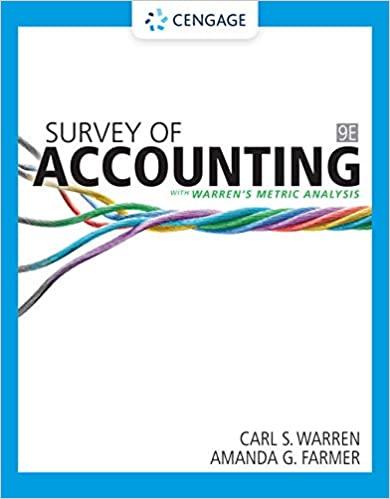Question
1.A production report is divided into two sections: a. work in process and completed goods b.a unit information section and a cost information section c.
1.A production report is divided into two sections:
a. work in process and completed goods
b.a unit information section and a cost information section
c. finished good and cost of goods sold
d.goods produced and goods in process
2.The cost of production report
a.
provides information about the physical units processed by the department and provides information about the manufacturing costs incurred by the department
b.
provides information about the manufacturing costs incurred by the department
c.
provides information about the physical units processed by the department
d.
none of these answers
3.Process accounting can be appropriate for
a.
service firms.
b.
manufacturing firms with JIT orientation.
c.
traditional manufacturing firms.
d.
all of these.
4.Equivalent production expresses all activity of the period in terms of
a.
work in process
b.
materials labor and overhead
c.
fully completed units
d.
partially completed units
5.How should the costs and work of beginning work in process be treated?
a.
Weighted average method
b.
FIFO method
c.
sequential processing method
d.
Both the weighted average and FIFO method can be used
6.Which statement best describes the concept of equivalent units of production?
a.
Equivalent units are the measure of a period's output
b.
Equivalent units are the units completed in a department
c.
Equivalent units are the total of the units produced by all departments
d.
Equivalent units are the number of units completed at the end of the last process
7.What does the accountant need to know to calculate unit cost?
a.
materials cost plus overhead
b.
the output for a period and the manufacturing costs for the department for that period
c.
conversion costs and prime costs
d.
total units produced by all departments
8.Simplicity is the main advantage of which of the following process costing methods?
a.
LIFO
b.
FIFO
c.
Weighted average
d.
Exact cost method
9.When computing equivalent units of production, the method that combines partially completed units in beginning inventory with current period production is the
a.
FIFO method
b.
LIFO method
c.
weighted average method
d.
actual cost method
10.What is the major advantage of the weighted average cost method?
a.
Simplicity
b.
Accuracy
c.
it is the required method
d.
it is the preferred method
11.Process costing would be most appropriate for which of the following?
a.
soft drink bottler
b.
custom home builder
c.
Caterer
d.
photocopy shop
12.Which of the following methods considers the percentage of completion of ending work-in-process?
a.
FIFO
b.
weighted average
c.
neither FIFO or weighted average
d.
both weighted average and FIFO
13.The Fox Company uses the weighted average method. The beginning work in process consists of 20,000 units (100% completed as to materials and 50% complete as to conversion costs). The number of units completed was 80,000. The ending work in process consists of 10,000 units (100% complete as to materials and 20% complete as to conversion costs). The equivalent units of production for conversion costs was:
a.
110,000
b.
82,000
c.
80,000
d.
90,000
14.Beginning inventory for the month contained 2,000 units that were 70 percent complete with respect to materials. During the month, 60,000 units were completed and transferred out. Ending inventory contained 3,000 units, 20 percent complete with respect to materials. The weighted average equivalent units of production for materials for the month would be
a.
62,400
b.
63,000
c.
60,600
d.
60,000
Step by Step Solution
There are 3 Steps involved in it
Step: 1

Get Instant Access to Expert-Tailored Solutions
See step-by-step solutions with expert insights and AI powered tools for academic success
Step: 2

Step: 3

Ace Your Homework with AI
Get the answers you need in no time with our AI-driven, step-by-step assistance
Get Started


